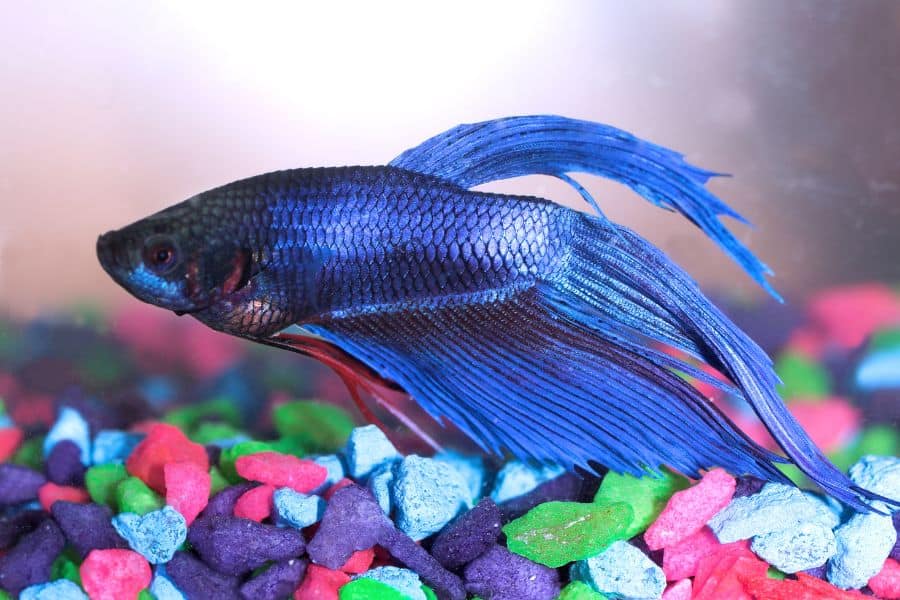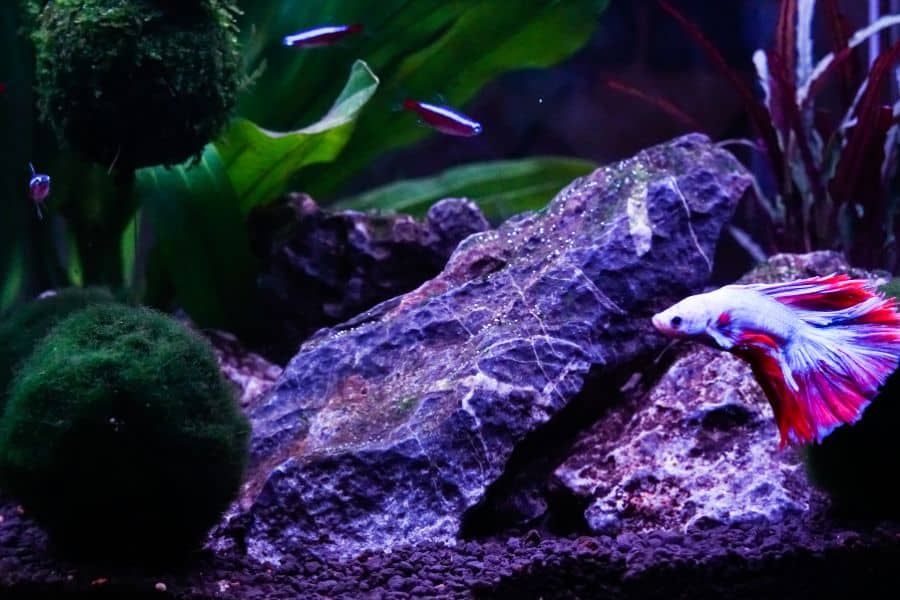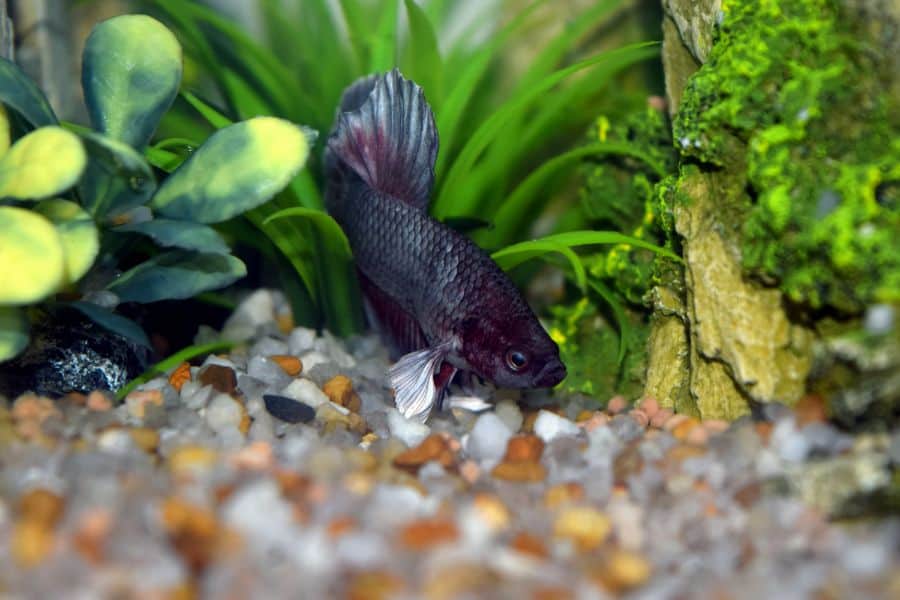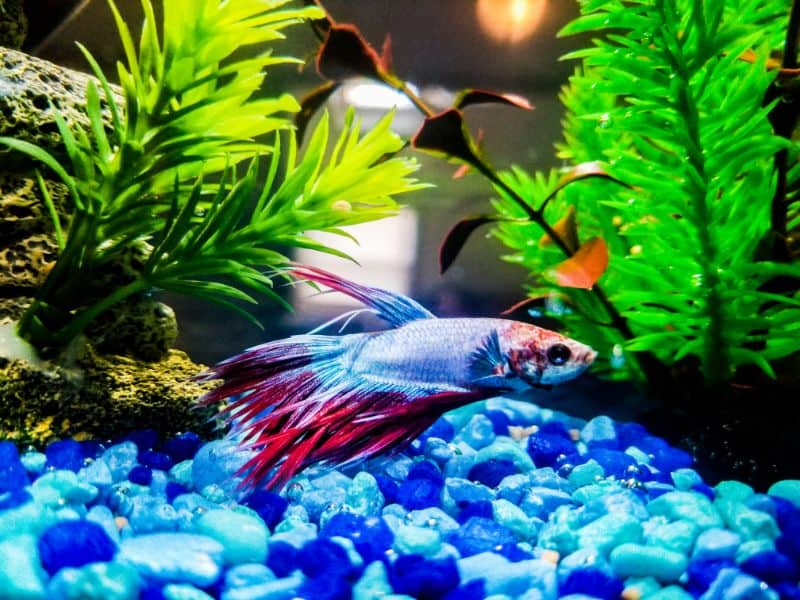As a Betta owner, few things are more worrying than seeing your Betta fish laying on the bottom of the tank, motionless.
While there are many possible reasons for this unusual behavior–some of which are completely harmless–it can also be a sign that your Betta is experiencing a serious health problem or issue.
To help you out, let’s talk about the most frequent causes of a Betta fish laying on the bottom of the tank and what you can do about each one!
11 Common Reasons Why Your Betta Fish Is Laying on The Bottom of The Tank
Not all reasons for a Betta fish to lay at the bottom of the tank are related to health issues. Here are some non-concerning reasons why you may find your Betta fish laying on the bottom of its tank.
1. Stress
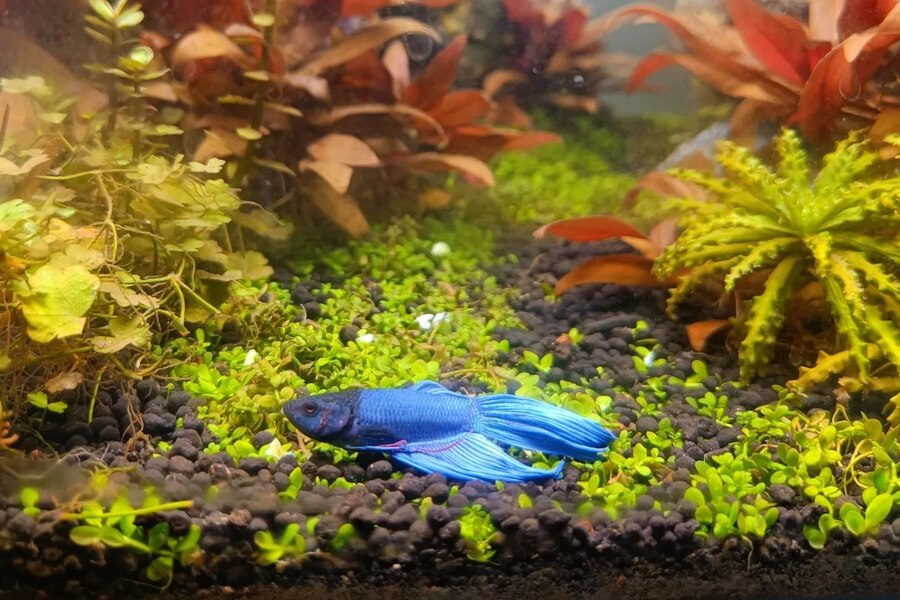
Bettas can become stressed when they’re transferred to a new tank, introduced to new tankmates, or placed in an overstocked aquarium.
If you’ve recently put your Betta fish through some changes and it’s always spending time at the bottom of the tank, it might just be feeling a bit stressed. You should probably give it some time to adjust before considering any intervention.
However, keep in mind that severe stress over an extended time can cause serious problems for your Betta. Make sure you watch out for these tell-tale signs:
- Horizontal stress stripes
- Dullness in color
- Lack of appetite
- Complete inactivity
- Gasping at the surface
If you see many of these symptoms in your Betta, jump ahead to our next section, where we’ll discuss the serious reasons why your Betta is laying on the bottom of the tank.
2. Sleeping
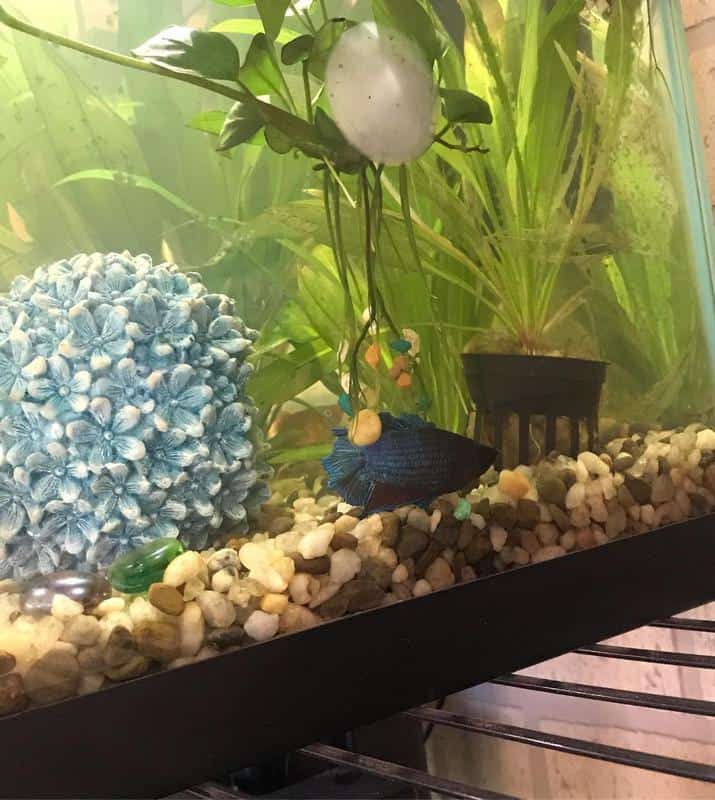
Did you know that Bettas are big on sleep? These active little fishes are naturally adventurous and are constantly swimming about, so it’s no wonder that they get tired every now and then. When they’re tired, they may opt to sleep or rest at the bottom of the tank, where the water is more still and they’re less likely to get bothered by other active tankmates.
That said, there are much better areas for them to sleep, such as near the surface of the tank. This is why we recommend adding plants with broad leaves, such as Anubias Barteri, Tiger Lotus, or Amazon Swords for them to hide and rest in.
If you don’t have a planted tank, you can set up a Betta leaf or a Betta hammock for them instead. Another option would be a floating Betta log. All three will provide your Betta with a snug and secure spot to rest, even if you don’t have plants inside your tank.
3. Water Current Too Strong
Betta fish may be active swimmers, but they’re not strong swimmers.
In the wild, Bettas are used to living in still waters such as ponds or rice paddies, so they’re not well equipped to cope with strong currents.
If the water flow or current inside your Betta tank is too strong, it may cause them to spend most of their time hanging out at the bottom of the tank. That’s because this is the area where the current is least powerful.
Luckily, fixing this problem isn’t too difficult, as it’s usually rooted in your filter or air bubbler. All you have to do is to switch to a less powerful filter or reduce the airflow to your air bubbler by installing an adjustable valve.
We recommend using a simple air pump and sponge filter setup for your Betta fish. Not only does it eliminate the risk of fish accidentally getting stuck inside the filter, but it’s also gentler on their delicate fins and scales.
If you really prefer a power filter, though, one of the safest options is the Aqueon QuietFlow Internal Shrimp Filter. This filter was designed specifically for invertebrates and small fish, so you can be sure that it won’t harm or stress out your Betta.
4. Tank Too Small
Betta fish are often thought of as beginner fish, and this introduces a whole host of problems. One of them is that many new aquarium owners mistakenly assume they can keep a Betta in anything, including a tiny bowl that barely holds a gallon of water.
Unfortunately, this isn’t the case at all. Wild Bettas are used to swimming in large bodies of water, so a tiny bowl or tank is unlikely to provide them with enough space to swim and explore. This can lead to stress and depression in your Betta, which may result in them staying put at the bottom of their tank.
The best way to combat this problem is to simply move your Betta to a bigger tank. We recommend a minimum of 2.5 gallons for one lone Betta fish to give them enough space to move around. Ideally, you should go for 5-10 gallons, though, as this allows for more decorations, hiding places, and even tankmates.
5. Temperature Too Hot or Too Cold
Bettas are tropical fish, which means their ideal water temperatures range from 75°F to 80°F (or 24-27°C).
Although the temperature can go beyond these values in the wild, it typically doesn’t stay constant throughout the day. In an aquarium, though, these temperatures can oftentimes stay the same, leading to long-term negative effects for your fish.
One way to tell if the water temperature in your Betta tank is incorrect is to observe the way your Betta behaves. When the temperature is out of their ideal ranges, Bettas will become lethargic or sluggish. This can result in them spending more time resting at the bottom of the tank.
The most straightforward way to fix this issue is to add a heater to your Betta tank. This way, you can adjust the water temperature to your Betta’s needs and keep it consistent throughout the day.
If you want to stay on top of your tank’s temperature, you can install a water thermometer inside the tank. You can choose from simple thermometers like Penn Plax’s digital strip thermometer, or more expensive but also more detailed thermometers like Capetsma’s Touchscreen LCD digital thermometer.
6. Incorrect Water Parameters
Bettas may be hardy fish, but they’re not invincible. Actually, they’re rather sensitive to certain water parameters, and even small changes can cause them a lot of stress.
For instance, water that’s too hard is harmful to Betta fish, as too many dissolved solids prevent oxygen from getting into their gills. Additionally, water that has the wrong pH can also lead to health issues, as Bettas need slightly acidic water with a pH between 6.5 and 7.
What makes this problem worse is that the smaller the tank, the more it suffers from fluctuations in water parameters.
So, if you have a small tank and don’t regularly check your water parameters with something like the API Freshwater Master Test Kit, your Betta fish might be suffering from the wrong water conditions without you even noticing.
7. Poor Tank Maintenance
Poor tank maintenance can also be the culprit behind a Betta laying at the bottom of its tank.
Weekly partial water changes are essential for any aquarium, Betta tanks included. In fact, you should do 25-50% water changes each week, depending on your tank size, to keep the aquarium clean and healthy.
Additionally, you should keep the tank’s decorations and substrate clean as well. Over time, algae can grow on the surfaces of your aquarium, leading to poor water quality and making it difficult for your Betta to swim around.
To prevent this from happening, you should regularly clean the tank’s decorations with an algae magnet and vacuum the substrate to remove any debris. This will help keep your tank clean and your Betta healthy.
8. Incompatible Tankmates
Although it’s completely possible to keep Bettas and other species in the same tank, it’s not as easy as it sounds.
Bettas are territorial and aggressive fish, meaning they won’t hesitate to protect their territory against other tankmates. If you put them in an overcrowded tank or with aggressive fish, they may become extremely stressed. As time goes by, they may choose to spend more time resting at the bottom of the tank to get away from the stressors.
As the adage goes, prevention is better than cure, so the best thing you can do here is to make sure to research any potential tankmates before adding them to the same aquarium as your Betta.
You should also observe your Betta’s personality to see if it’s receptive to new tankmates. Some Bettas are so territorial that they flare at and attack even harmless tankmates like shrimp or snails.
Of course, if you already have an overcrowded tank with incompatible tankmates, then you should think about rehoming some of the fish or setting up another aquarium for them.
9. Malnourishment
Wild Betta fish have a variety of food options, such as plants, algae, insects, and detritus available at their disposal. Pet Bettas, however, have to rely entirely on you for their sustenance.
If you’re feeding your fish low-quality or species-inappropriate food, it’s possible that they’re not getting all the necessary vitamins and nutrients they need to sustain their health.
To fix this, you should try to provide your Betta with a varied and nutritious diet. Start by looking for food specifically designed for Betta fish, like Hikari Betta Bio-Gold or Omega One Betta Buffet pellets.
You should also feed your Betta live or freeze-dried foods every now and then to mix it up. Bettas love treats such as bloodworms, brine shrimp, and daphnia.
10. Boredom
Bettas that are kept in small tanks with no decorations or stimuli can become bored and lethargic. Without anything to do, they may opt just to spend their time at the bottom of the tank, wasting away.
It’s a sad reality, for sure, but it’s not unfixable. You can help your Betta become more active by providing them with some interesting decorations such as plants, logs, and even bubblers. This gives your Betta fish something new to explore and interact with.
Some Betta owners also exercise their Bettas by letting them see themselves in a mirror for up to 5 minutes per day. This stimulates their natural behavior of flaring by letting them flare at their own reflection.
11. Age
Bettas aren’t immortal, which means they’ll eventually start to slow down as they age. When this happens, it’s not unusual for them to spend more time resting at the bottom of the tank.
Pet Betta fish typically live for about 3-5 years. If your Betta is on the older side, it will start experiencing tiredness much sooner, resulting in more breaks in between swimming sessions.
Betta leaves, hammocks, and logs can help give your elderly fish a comfortable spot to rest, so do consider adding these decorations to your tank.
4 Serious Reasons Why Your Betta Fish Is Laying on The Bottom of The Tank
Sadly, there are also some more serious reasons that can explain why your Betta fish is laying at the bottom of the tank. Here are four potential issues you’ll want to keep in mind when trying to diagnose the issue.
1. Disease
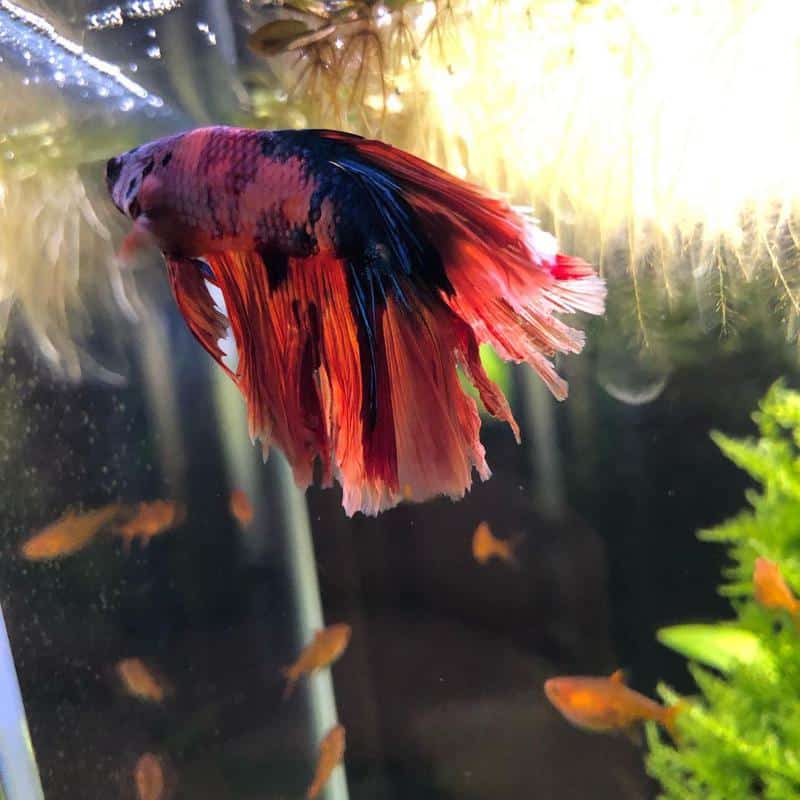
Bettas can contract a variety of diseases and illnesses, some of which can cause them to lie at the bottom of the tank.
For example, if your fish has fin rot, an infection caused by bacteria that attack the fish’s fins, then it may be too weak to swim and opt to just rest at the bottom instead.
The same goes for gill flukes, columnaris, dropsy, and more. If you think your Betta may be suffering from any of these diseases, it’s important to do a thorough examination and consider giving them treatment.
2. Swim Bladder Disorder
While it’s also technically a disease, we’re putting swim bladder disorder in its own category. That’s because it’s a very common yet potentially fatal issue that can be caused by a variety of factors, ranging from poor diet to physical trauma.
This is a condition that impacts the swim bladder of the fish, a sac that enables them to float. When the swim bladder is damaged in any way, fish will not be able to swim appropriately and may sink to the tank’s bottom. They may also appear to be swimming sideways, upside down, or even in circles.
Some of the most common causes of swim bladder disorder or swim bladder disease include:
- Infection, typically the bacterial kind
- Physical trauma or injury
- Tumors or cancerous growths
Depending on the exact cause of the swim bladder disorder, you may be able to treat your Betta yourself. If it’s something serious, though, the best route to take would be to the vet for a thorough checkup.
3. Poisoning
Another possible cause of why your Betta fish is laying at the bottom of the tank could be poisoning. Betta fish are very sensitive to chemicals, which means they can become poisoned after being exposed to certain substances.
The most common type of poisoning in fish tanks is ammonia poisoning. This type of poisoning occurs when there’s an uncontrolled buildup of ammonia inside the tank. Left untreated, ammonia poisoning can result in your Betta’s organs getting damaged, eventually leading to their death.
Other types of common fish tank poisonings include nitrate poisoning and copper poisoning. In order to prevent your Betta from being poisoned, include regular testing as part of your maintenance tasks. You can also use a conditioner like Seachem Prime to quickly detoxify the tank water.
4. Injuries
Lastly, it’s possible that your Betta fish is laying at the bottom of the tank due to injuries.
Injuries can be caused by a variety of things, such as sharp objects inside the tank or aggressive fish. If you think something of this sort might be happening, it’s important to remove the source of danger immediately.
It’s also possible that your Betta fish has already gotten injured and is now trying to rest at the bottom of the tank. This isn’t really a bad thing, of course, but you should probably still do a quick checkup and make sure everything looks normal.
Also Read:
FAQs
Is It Normal for My Betta to Be Resting at The Bottom of The Tank?
Whether laying on the bottom of the tank is normal or not depends on what symptoms are visible in your Betta fish. If your Betta isn’t showing any other symptoms, then there’s likely no need to be concerned. However, if your Betta is also displaying serious signs like the ones mentioned above, you may want to start considering treatment options.
How Can I Prevent My Betta from Laying on The Bottom of The Tank?
If you want to prevent your Betta from laying on the bottom of the tank, you should keep an eye on its health, tank environment, and diet. Make sure the tank is adequately sized and equipped with a filter and heater and that you’re consistently cleaning it. Also, feed your Betta with a varied and highly nutritious diet.
Conclusion
There’s no need to worry if your Betta is occasionally laying at the bottom of the tank. As you’ve seen in this article, there are plenty of reasons why your Betta could be resting there, and if it’s not displaying any other symptoms, the issue is probably minor.
However, if you do see other signs of illness, it’s important to consider giving treatments to your Betta or even taking it to a vet.
At the end of the day, what’s truly important is that you act quickly to prevent the issue from getting worse. With a little bit of care and attention, you should be able to keep your Betta healthy and actively swimming!
